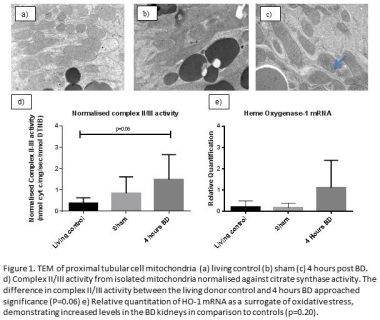The Use of Systems Biology to Identify Mitochondrial Dysfunction and Metabolic Dysregulation as Targets for Intervention in the Brain Dead Organ Donor
Oxford Transplant Centre, University of Oxford, Oxford, Oxfordshire, United Kingdom.
Meeting: 2015 American Transplant Congress
Abstract number: B269
Keywords: Brain death, Ischemia, Kidney transplantation
Session Information
Session Name: Poster Session B: Translational Genetics and Proteomics in Transplantation
Session Type: Poster Session
Date: Sunday, May 3, 2015
Session Time: 5:30pm-6:30pm
 Presentation Time: 5:30pm-6:30pm
Presentation Time: 5:30pm-6:30pm
Location: Exhibit Hall E
Introduction: Due to the persistent donor shortage many centres accept older, higher risk organs which have inferior outcomes. Understanding how kidneys are injured during brain death (BD) will allow the development of new strategies to protect kidneys in the donor.
We previously reported, using proteomics and metabolomics that mitochondrial dysfunction and metabolic dysregulation occurs following BD [WTC 2014]. To gain further insight, we characterised the effects of BD on mitochondrial morphology, enzyme function and oxidative stress.
Methods: Kidney samples were compared from BD rats against sham and living donor controls as previously described. Following BD, ventilation was continued for 4 hrs.
Transmission electron microscopy (TEM) was performed using 80nm sections cut and stained in uranyl acetate and lead citrate. Complex II/III activity was performed on isolated mitochondrial as previously described. RT-PCR was used to investigate mRNA levels of HO-1 as a surrogate marker of oxidative stress.
Results: Morphology of mitochondria in the proximal tubular compartments of the cortex demonstrated heterogeneous appearances. Increased detachment of cristae were noted in the BD group compared to sham and living donor controls. 
A progressive increase in complex II/III activity was found in the BD group (1.49 +/- 1.17 nmol cytc/mg/sec/nmol DTNB) compared to living donor (0.37 +/-0.27) and sham controls (0.85 +/- 0.77). Relative quantitation of HO-1 mRNA level demonstrated a similar pattern.
Conclusion: We have shown morphological evidence of mitochondrial injury in comparison to controls. In addition we detected a trend towards increased complex II/III activity in the BD group that together with the omics data and HO-1 levels suggests metabolic disturbance and oxidative stress.
Strategies to improve outcomes of transplantation from BD donors need to address the metabolic demands and mitochondrial injury occurring during BD, possibly through metabolic reprogramming using the HIF pathway.
To cite this abstract in AMA style:
Akhtar M, Faro LLo, Robelledo R, Kaisar M, Huang H, Leuvenink H, Friend P, Fuggle S, Pugh C, Ploeg R. The Use of Systems Biology to Identify Mitochondrial Dysfunction and Metabolic Dysregulation as Targets for Intervention in the Brain Dead Organ Donor [abstract]. Am J Transplant. 2015; 15 (suppl 3). https://atcmeetingabstracts.com/abstract/the-use-of-systems-biology-to-identify-mitochondrial-dysfunction-and-metabolic-dysregulation-as-targets-for-intervention-in-the-brain-dead-organ-donor/. Accessed December 29, 2025.« Back to 2015 American Transplant Congress
